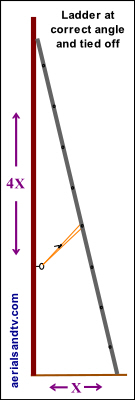Basic Ladder Safety
This is not meant to be an exhaustive article on the use of ladders, it's just a reminder of the most important things to remember when using one.
Surface : The ground on which the ladder is to be rested should be firm, and not slippery.
I'd have thought both of these went without saying, but then again...
Level the ladder : Use of a ladder leveller is the best idea, but not everyone has one of those. Never use wooden wedges or a stone. Place a large piece of plywood (neither painted nor wet) under the ladder leg with the gap under it. Chock the board so it levels the ladder but, just as importantly, it's stable and isn't going to go anywhere.
Angle of the ladder : This should be about 70 degrees from the horizontal, a more practical check is the 4 up 1 out rule, e.g. if the top of the ladder is 8m from the ground, the base should be 2m out from the wall. Some ladders have a "ladder line" at the correct angle marked on the side.
Tie the ladder off : Tying a ladder off is time consuming, and, to be honest, most people don't bother. But it could save your life, or at least ensure you don't end up playing wheelchair basketball...... If it's done properly it not only makes using a ladder far safer, but it will give you much more confidence in its use. Instead of flexing and wobbling as you climb it the ladder will stay rock steady, like going up stairs, literally, try it and you'll see what I mean. And if you do over balance you can grab the ladder, and you won't experience that sickening feeling as it starts sliding...
The best way to tie off a ladder is with one of those small ratchet straps used for securing luggage or similar, but if you haven't got one of those anything which is reasonably strong (and capable of getting a fair bit of tension on the tie off) is better than nothing. If there isn't anything convenient to tie off to then screw an eye screw / eyebolt into the wall, one of these is included in all our Chimney or Wall or Starlink install kits. It'll only leave a small hole when you remove it and you may, at some time in the future, want to use it again anyway. Loop the strap round a rung about half way up, then angle it downwards about 45 degrees because you don't want to just drag the bottom of the ladder in towards the wall. Do not put too much force on the strap because that'll just damage the ladder. All you want to do is take up any play in the ladder and ensure it doesn't move.
If using a ladder in conjunction with a roof ladder always lash the two together at the point they meet at the edge of the roof. Apart from ensuring the ladder doesn't fall (and leave you embarrassingly stranded up on the roof! ) if you do fall down the roof you have at least got something to grab onto [i.e. the top of the ladder] which isn't going to move. [link]

Don't over reach : Saying don't reach out to the side when using a ladder is obvious, but also pretty stupid, because for most jobs you have to. The thing is don't reach out too far, particularly if the ladder isn't tied off, which is another reason for tying it off in the first place.
Top of the ladder : This should be above the top of the wall, by a couple or three feet, this gives you something to hold onto as you climb onto the roof (or whatever), and also something to grab onto if you fall off the roof, so long as it's tied off, obviously.
To be honest it's very rare for aerial installers to ever fall off the roof, though it's not unknown. Just so long as you're careful it's pretty safe fitting the odd aerial. Compare it to driving (over the years you do it), now that is dangerous...

